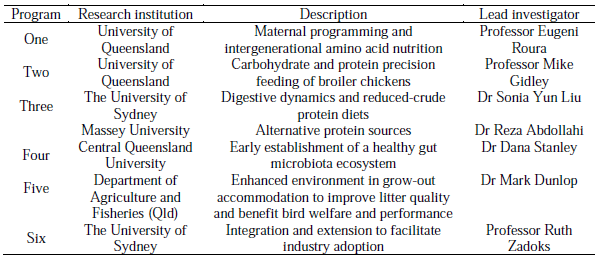A Project Designed to Promote Environmentally Viable Chicken-Meat Production via Enhanced Nutrition, Gut Integrity and Housing
This paper outlines the Project designed to promote environmentally viable chicken-meat production via enhanced nutrition, gut integrity and housing, and the Project is funded by AgriFutures Australia. Five Australasian institutions have formed a partnership to complete the necessary research and the objectives are briefly discussed.
I. BACKGROUND

II. PROJECT OUTLINE
Ajao AM, White D, Kim WK & Olukosi OA (2022) Animals 12: 2662.
Alexandratos N, Bruinsma J (2012) Working paper No.12-03. FAO, Rome.
Australian Chicken Meat Federation (2022) https://www.chicken.org.au› facts-and-figures. Accessed 11/10/2022.
Bessei W (2006) World’s Poultry Science Journal 62: 455-466.
Celi P, Cowieson AJ, Fru-Nji F, Steinert RE, Kluenter A-M & Verlhac V (2017) Animal Feed Science and Technology 234: 88-100.
Cowieson AJ & Selle PH (2011) Recent Advances in Animal Nutrition in Australia 18: 157-164.
Dunlop MW, Moss AF, Groves PJ, Wilkinson SJ, Stuetz RM & Selle PH (2016) Science of the Total Environment 562: 766-776.
Fiala N (2008) Ecological Economics 67: 412-419.
Garland PW (2018) Proceedings of the Australian Poultry Science Symposium 29: 1-7.
Gasparri NI, Grau HR & Gutierrez AJ (2013) Global Environmental Change 23: 1605-1614.
Giuberti G, Gallo A, Cerioli C & Masoero F (2012) Animal Feed Science and Technology 174: 163-173.
Herwig E, Abbott D, Schwean-Lardner KV & Classen HL (2019) Poultry Science 98: 3676-3684.
Kadam MM, Barekatain MR, Bhanja SK & Iji PA (2013) Journal of Science of Food and Agriculture 93: 3654-3661.
Khan SH (2018) Journal of Applied Animal Research 46: 1144-1157.
Lesuisse, J, Schallier S, Li C, Bauti A, Li B, Leblois J, Buyse J & Everaert N (2018) Poultry Science 97: 1666-1676.
Liu SY, Selle PH (2017) Animal Production Science 57: 2250-2256.
Meda, B, Hassouna M, Aubert C, Robin P & Dourmad JY (2011) World’s Poultry Science Journal 67: 441-456.
Moraes TGV, Pishnamazi A, Mba ET, Wenger II, Renema RA & Zuidhof MJ (2014) Poultry Science 93: 2818-2826.
Moss AF, Sydenham CJ, Khoddami A, Naranjo VD, Liu SY & Selle PH (2018) Animal Feed Science and Technology 237: 55-67.
Ndotono EW, Khamis FM, Bargul JL & Tanga CM (2022) Microorganisms 10: 351.
Ryś R & Koreleski J (1979) Archives of Animal Nutrition 29: 181-188.
Selle PH, de Paula Dorigam JC, Lemme A, Chrystal PV & Liu SY (2020) Animals 10: 729.
Selle PH, Macelline SP, Greenhalgh S, Chrystal PV & Liu SY (2022) Animal Nutrition 11: 181-189.
Stanley D, Hughes RJ & Moore RJ (2014) Applied Microbiology and Biotechnology 98: 4301-4310.
Stanley D, Hughes RJ, Geier MS & Moore RJ (2016) Frontiers in Microbiology 7: 187.
Sydenham CJ, Truong HH, Moss AF, Selle PH & Liu SY (2017) Animal Feed Science and Technology 227: 32-41.
Tahamtani FM, Pedersen IJ & Riber AB (2020) Poultry Science 99: 21-29.
Uni Z & Ferket PR (2004) World’s Poultry Science Journal 66: 101-111.
Vaarst M, Steenfeldt S& Horsted K (2015) World’s Poultry Science Journal 71: 609-620.
Van Der Waaij EH, Van Den Brand H, Van Arendonk JAM & Kemp B (2011) Animal 5: 741-748.
Van Harn J, Dijkslag MA & van Krimpen MM (2019) Poultry Science 98: 4868-4877.
Wang N & Daun JK (2004) Journal of the Science of Food and Agriculture 84: 1021-1029.
Wu G, Bazer FW & Cross HR (2014) Annals of the New York Academy of Sciences 1328: 18-28.












